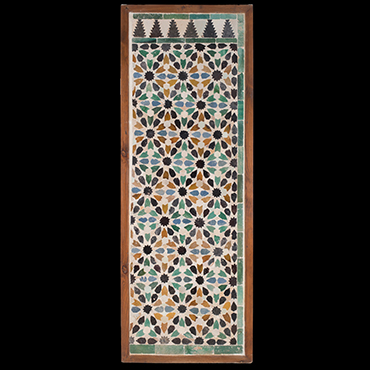The Museum of the Alhambra, Granada and the Victoria and Albert Museum, London present an exploration of Nasrid-era geometric aesthetics and their reception by the British architect Owen Jones (AH 1223–90/1809–74 CE), who studied the Alhambra’s ornamental schemes in an attempt to understand its underlying design principles.
The Alhambra was built iteratively from at least the 5th century AH/11th century CE, when it was the site of a Zirid military fortress. From AH 633 to 897/1236 to 1492 CE, the Nasrid family developed it extensively, building a new fortress (al-qasabah) and a royal city equipped with palaces, mosques, gardens, irrigation systems as well as workshops to supply its needs. Surrounded by a fortified curtain wall, the Alhambra became a world apart, a site for artistic expression, where pattern, color and the written and spoken word were integrated into the study of optics, physics and emotional effect. Today, the Alhambra still evokes a perception of striking beauty.
Owen Jones arrived at the Alhambra in AH 1249/1834 CE together with a friend, the French architect Jules Goury. A cholera epidemic enforced a six-month stay during which the two men studied the design principles on which the Alhambra’s unique ornament was based, painstakingly drawing every inch of the palaces in an informed and realistic style.
The V&A holds an important collection of Owen Jones’s drawings, which formed the foundation for his landmark publications, Plans, Elevations, Sections and Details of the Alhambra (1842–1845) and The Grammar of Ornament (1856). By reuniting these seminal drawings with the Alhambra objects that inspired them, this presentation celebrates Jones’ meticulous work and role in inspiring an enduring fascination for the Alhambra style amongst artists and architects alike.
Victoria and Albert Museum, London
Founded in AH 1268/1852 CE, the Victoria and Albert Museum (V&A) is a family of museums dedicated to the power of creativity. The V&A celebrates and shares—through a program of exhibitions, events, educational and digital experiences—a collection of 2.8 million objects, support for new works, and a commitment to conservation, research, and sustainable design to inspire the makers, creators, and innovators of today. The V&A holds over 19,000 items from the Middle East and North Africa, from the early Islamic period to now.
In AH 1444/2023 CE, The Diriyah Biennale Foundation supported the V&A to create the Ramadan Pavilion in London, to celebrate the lived experiences of Muslims across the UK. In AH 1445/2024 CE, the V&A opened the seventh edition of the Jameel Prize, an international award for contemporary art and design supported by Art Jameel. The prize explores the relationship between contemporary practice and Islamic tradition as part of a wider debate about Islamic culture in the 15th century AH/21st century CE.
Recognizing AlMadar as a rare and unique cultural moment drawing together and juxtaposing collections of historical objects from Islamic civilizations from around the world, the V&A joins with a presentation of drawings made at the Alhambra by Owen Jones, Nasrid woodwork, and an 11th-century AH/17th-century CE manuscript by Abulrahman al-Sufi.
Almizate (flat central section) from a carpentry ceiling
The almizate formed the central, flat section of a ceiling to which sloping panels would have been affixed. One of the short ends of the almizate is flat, indicating that it is incomplete and originally longer. It may have been part of a ceiling covering an exterior gallery of a house. When it was bought for the V&A in AH 1296/1879 CE by the curator (later, director), Caspar Purdon Clarke, its origin was recorded as “the House of ‘El Rey Chico’ (Boabdil), at Granada, Spain, recently destroyed”. “El Rey Chico” (the young king) and “Boabdil” are both Spanish historical names for the last Nasrid sultan of Granada, Abu Abdullah Muhammad XII, who surrendered to the Catholic Monarchs (Isabel I and Ferdinand V) in AH 897/1492 CE.
Recent research suggests that the almizate came from another Nasrid-era house in the Albaicín, the neighborhood in Granada opposite the Alhambra citadel. In the 13th century AH/19th century CE, the house was known as La Casa de las Monjas (The Nuns’ House). It was demolished in AH 1294/1877 CE, just two years before Purdon Clarke acquired the almizate. Other architectural elements from the house are said to be housed by the Museum of the Alhambra. AlMadar has provided the opportunity to rediscover the almizate, to conserve it, and to bring it back to public and scholarly attention.
Granada, al-Andalus, early to mid-9th century AH/early to mid-15th century CE
Wood (perhaps pine), h. 218 × w. 97 × d. 16 cm, 85 kg
Victoria and Albert Museum, London, 8–1880

